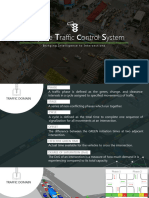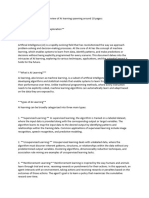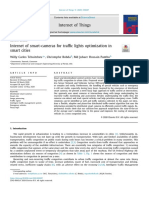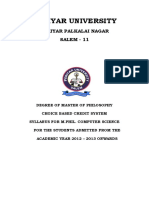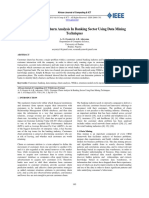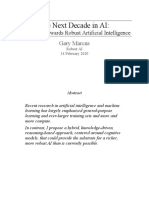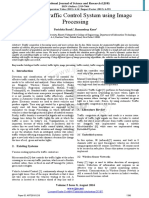AI-Based Adaptive Traffic Signal Control For Congestion Mitigation
Uploaded by
IJMSRTAI-Based Adaptive Traffic Signal Control For Congestion Mitigation
Uploaded by
IJMSRTVolume-3, Issue-4, April 2025 International Journal of Modern Science and Research Technology
ISSN No- 2584-2706
AI-Based Adaptive Traffic Signal Control for
Congestion Mitigation
Ramesh Kumar
Karnataka State Open University, Mysore
Abstract
Urban traffic congestion is a growing ownership and traffic volume, placing
challenge faced by cities worldwide, unprecedented pressure on city
resulting in economic losses, increased infrastructure. Conventional traffic
pollution, and reduced quality of life. management systems, which rely on fixed-
Traditional traffic signal systems operate time signal plans or manually adjusted
on pre-timed schedules that are often schedules, often struggle to adapt to real-
inadequate in responding to real-time time traffic conditions. This results in
traffic fluctuations. Artificial Intelligence bottlenecks, delays, and inefficient use of
(AI) offers a dynamic alternative through road networks [1].
adaptive traffic signal control systems that Artificial Intelligence presents a
respond to real-time traffic data, optimize transformative opportunity to modernize
flow, and reduce congestion. This paper traffic signal control. By analyzing real-
explores the foundational technologies time traffic data and learning from patterns
behind AI-based traffic signal control, over time, AI systems can dynamically
focusing on machine learning algorithms, adjust traffic signal timings to optimize
computer vision, and reinforcement flow and reduce congestion. These
learning. It presents use cases in dynamic systems are central to the vision of smart
signal timing, emergency vehicle cities, where data-driven approaches
prioritization, and multimodal traffic enhance urban livability and sustainability
management. Case studies from smart [2].
cities globally demonstrate the This paper examines the use of AI in
effectiveness of AI in reducing congestion adaptive traffic signal control for
and travel time. Ethical considerations, congestion mitigation. It explores the core
including privacy, accessibility, and technologies, practical applications, and
algorithmic fairness, are discussed real-world implementations of AI-based
alongside technical challenges such as systems. It also addresses the ethical and
sensor reliability, system scalability, and logistical challenges associated with
integration with legacy infrastructure. deploying such technologies and outlines
Future directions include the integration of future innovations in intelligent traffic
connected vehicle data, edge computing, management [3].
and decentralized traffic control systems.
AI-driven adaptive signal control systems Foundations of AI in Adaptive Signal
are key components of intelligent Control
transportation networks, enabling more AI-based adaptive traffic signal control
efficient, responsive, and sustainable urban relies on several key technologies,
mobility. including traffic detection systems, data
Keywords: AI, Traffic Signal, processing platforms, and learning
Management, Control algorithms. These systems gather real-time
traffic data through cameras, loop
Introduction detectors, radar sensors, GPS data from
The rapid urbanization of the 21st century vehicles, and mobile devices [4].
has led to a dramatic increase in vehicle
IJMSRT25APR065 www.ijmsrt.com 309
DOI: https://doi.org/10.5281/zenodo.15314017
Volume-3, Issue-4, April 2025 International Journal of Modern Science and Research Technology
ISSN No- 2584-2706
Machine learning models analyze this data Emergency vehicle prioritization allows
to identify traffic flow patterns, congestion AI systems to detect the approach of
points, and optimal signal timings. ambulances or fire trucks and alter signal
Supervised learning techniques are used phases to grant them immediate passage.
for traffic prediction, while unsupervised This not only reduces response times but
learning supports anomaly detection and also minimizes disruptions to overall
clustering of traffic behaviors [5]. traffic flow [12].
Reinforcement learning, particularly deep Pedestrian and cyclist integration is
reinforcement learning (DRL), is widely enhanced through AI that detects non-
used for real-time traffic signal motorized users and allocates safe crossing
optimization. In this approach, the AI times dynamically, balancing the needs of
agent learns by interacting with the traffic all road users [13].
environment, receiving feedback in the Multimodal traffic management uses AI to
form of rewards (such as reduced vehicle coordinate traffic signals with public
delay or queue length) and improving its transportation systems. For example, buses
policy over time. Techniques such as Q- may be given signal priority at
learning, Deep Q-Networks (DQN), and intersections to maintain schedule
Actor-Critic models have shown success in adherence and encourage public transit use
simulating adaptive traffic control [6]. [14].
Computer vision enhances AI capabilities Event-based signal adaptation enables the
by processing video feeds to detect vehicle system to respond to temporary traffic
types, count vehicles, and estimate speed. anomalies caused by road construction,
Object detection models like YOLO and accidents, or public events, maintaining
SSD enable real-time vehicle tracking, optimal flow under non-standard
which informs the adaptive signal conditions [15].
algorithms [7]. Environmental optimization involves AI
The integration of Internet of Things (IoT) adjusting signal patterns to reduce vehicle
devices and edge computing supports low- idling, thus lowering emissions and
latency data processing at intersections, improving air quality in congested areas
enabling fast decision-making without [16].
reliance on centralized servers [8]. These use cases show how AI-driven
These foundational technologies allow AI systems contribute to smarter, more
systems to monitor traffic conditions, flexible traffic control strategies that
predict changes, and respond with address the diverse needs of modern urban
optimized signal adjustments, thereby transportation networks [17].
mitigating congestion and enhancing
overall traffic flow [9]. Case Studies and Applications
Numerous cities around the world have
Use Cases in Congestion Mitigation implemented AI-based adaptive signal
AI-based adaptive traffic control has control systems with measurable success
several important use cases that directly [18].
contribute to reducing urban congestion Pittsburgh, Pennsylvania deployed the
[10]. Surtrac system, which uses artificial
Dynamic signal timing is the most intelligence to coordinate traffic signals in
common application. AI systems analyze real time. Surtrac reduced travel times by
current traffic volumes at intersections and over 25 percent and vehicle idling by 40
adjust green light durations in real time to percent in pilot areas [19].
reduce vehicle queuing and improve In Hangzhou, China, Alibaba’s City Brain
throughput [11]. project integrated AI and big data analytics
to optimize traffic flow. The system
IJMSRT25APR065 www.ijmsrt.com 310
DOI: https://doi.org/10.5281/zenodo.15314017
Volume-3, Issue-4, April 2025 International Journal of Modern Science and Research Technology
ISSN No- 2584-2706
monitors over 1,000 intersections, Transparency is essential for public trust.
reducing congestion and improving Citizens and local governments must
emergency response times across the city understand how AI systems make
[20]. decisions and have mechanisms to audit
Los Angeles adopted the Automated and intervene when needed [27].
Traffic Surveillance and Control (ATSAC) Operationally, integrating AI with existing
system enhanced with AI capabilities to traffic infrastructure poses challenges.
monitor traffic patterns and dynamically Many cities operate on outdated systems
adjust signal timings, resulting in reduced that require significant upgrades to support
travel times and improved intersection intelligent control technologies [28].
performance [21]. System reliability and resilience are also
Singapore’s Land Transport Authority concerns. AI models must perform
introduced an AI-powered system that consistently under varying traffic
integrates traffic signal control with public conditions and be robust to sensor failures,
transport data. This system prioritizes cyberattacks, and unexpected disruptions
buses and adapts to changing traffic loads, [29].
supporting one of the most efficient transit Governance frameworks and inter-agency
systems in the world [22]. coordination are required to manage the
In the United Kingdom, Transport for deployment, maintenance, and oversight of
London piloted AI-controlled traffic AI traffic systems. These frameworks must
signals using reinforcement learning to also address liability in the case of system
adjust signal phases based on vehicle errors or failures [30].
counts and congestion levels, showing By proactively addressing these ethical
promising results in travel time reduction and operational issues, cities can ensure
[23]. that AI-based traffic management supports
These case studies highlight the potential not only efficiency but also public
of AI to revolutionize traffic management, accountability and inclusivity [31].
delivering tangible benefits in urban
mobility, efficiency, and sustainability Challenges and Limitations
[24]. Despite its promise, AI-based adaptive
traffic signal control faces several
Ethical and Operational Considerations challenges that hinder widespread
The deployment of AI in traffic adoption [32].
management raises important ethical and High implementation costs, including
operational concerns. One key issue is data sensors, cameras, networking
privacy. Traffic data, especially when infrastructure, and computing hardware,
derived from GPS-enabled devices or can be prohibitive for many municipalities,
license plate recognition, can reveal especially in developing countries [33].
sensitive information about individual Data quality is a major concern.
movement patterns. Ensuring data Incomplete, noisy, or biased traffic data
anonymization and secure handling is can degrade model performance and lead
critical [25]. to suboptimal signal control decisions.
Equity and accessibility must also be Continuous monitoring and calibration are
addressed. AI systems should not necessary to maintain accuracy [34].
disproportionately prioritize traffic flow in Model interpretability is limited in many
wealthier or central areas at the expense of deep learning-based systems. Lack of
underserved communities. Fairness audits transparency in decision-making can
and inclusive design can help ensure that hinder trust and complicate debugging and
benefits are distributed equitably [26]. policy compliance [35].
IJMSRT25APR065 www.ijmsrt.com 311
DOI: https://doi.org/10.5281/zenodo.15314017
Volume-3, Issue-4, April 2025 International Journal of Modern Science and Research Technology
ISSN No- 2584-2706
Scalability is another issue. Algorithms supporting seamless multimodal travel
that perform well in small-scale [41].
simulations may not generalize to large, Edge AI will enhance responsiveness by
heterogeneous traffic networks with processing data at the intersection level,
diverse road users and conditions [36]. reducing latency and dependency on
Latency and computational demand, central servers.
especially in real-time systems, require Digital twin models of traffic networks
careful system design and infrastructure will simulate different signal control
support. Edge computing and optimized strategies in real time, supporting scenario
algorithms are key to minimizing delays analysis and decision-making [42].
[37]. Crowdsourced data from navigation apps
Human factors must also be considered. and mobile devices will enhance
Traffic behavior is influenced by drivers’ situational awareness, enabling adaptive
responses to signal patterns, which can signals to respond to real-world conditions
vary unpredictably. AI systems must beyond fixed sensors.
account for human unpredictability to Sustainable urban mobility goals will
ensure safe and effective operation [38]. guide AI systems to prioritize low-
Interoperability with existing emission modes of transport and support
infrastructure, such as legacy traffic pedestrian-friendly signal timing in
controllers and communication protocols, alignment with environmental targets.
presents technical and administrative These innovations will position AI at the
hurdles that must be overcome through core of next-generation traffic
standardized platforms and policy management systems that are intelligent,
frameworks [39]. responsive, and aligned with the evolving
These challenges underscore the need for needs of urban mobility.
multidisciplinary research, stakeholder
engagement, and long-term investment to Conclusion
fully realize the benefits of AI-based AI-based adaptive traffic signal control
traffic management. offers a powerful solution to the growing
problem of urban congestion. By
Future Prospects and Innovations leveraging real-time data, machine
The future of AI-based adaptive traffic learning, and intelligent decision-making,
control is shaped by several emerging these systems improve traffic flow, reduce
technologies and innovations. delays, and support sustainable mobility.
Connected vehicle technology will allow While technical, ethical, and
vehicles to communicate directly with infrastructural challenges remain,
traffic signals, providing more accurate successful implementations around the
real-time data and enabling predictive world demonstrate the viability and
control based on vehicle trajectories and benefits of AI in traffic management.
intentions. Continued innovation, responsible
Decentralized traffic control systems using governance, and inclusive planning will be
multi-agent reinforcement learning will essential to ensure that intelligent traffic
enable intersections to learn and systems contribute to safer, more efficient,
coordinate autonomously, improving and more equitable cities.
scalability and resilience [40]. As urban populations continue to grow,
Integration with mobility-as-a-service AI-enabled adaptive signal control will
platforms will allow traffic signals to play a critical role in shaping the future of
respond to real-time demand across ride- transportation and urban living.
sharing, cycling, and public transit modes, 1. Kolluri, V. (2024). Revolutionizing
healthcare delivery: The role of AI
IJMSRT25APR065 www.ijmsrt.com 312
DOI: https://doi.org/10.5281/zenodo.15314017
Volume-3, Issue-4, April 2025 International Journal of Modern Science and Research Technology
ISSN No- 2584-2706
and machine learning in personalized Scientific Endeavours, 1(1), 1-7.
medicine and predictive analytics.
Well Testing Journal, 33(S2), 591- 8. Yarlagadda, V. S. T. (2018). AI for
618. Healthcare Fraud Detection:
Leveraging Machine Learning to
2. Gatla, T. R. (2017). A Systematic Combat Billing and Insurance Fraud.
Review Of Preserving Privacy In Transactions on Recent Developments
Federated Learning: A Reflective in Artificial Intelligence and Machine
Report-A Comprehensive Analysis. Learning, 10(10).
IEJRD-International Multidisciplinary
Journal, 2(6), 8. 9. Kolluri, V. (2024). Revolutionary
research on the ai sentry: an approach
3. Pindi, V. (2021). AI in Dental to overcome social engineering
Healthcare: Transforming Diagnosis attacks using machine intelligence.
and Treatment. International Journal International Journal of Advanced
of Holistic Management Perspectives, Research and Interdisciplinary
2(2). Scientific Endeavours, 1(1), 53-60.
4. Yarlagadda, V. S. T. (2024). Machine 10. Gatla, T. R. (2020). An In-Depth
Learning for Predicting Mental Health Analysis Of Towards Truly
Disorders: A Data-Driven Approach Autonomous Systems: Ai And
to Early Intervention. International Robotics: The Functions. IEJRD-
Journal of Sustainable Development International Multidisciplinary
in Computing Science, 6(4). Journal, 5(5), 9.
5. Boppiniti, S. T. (2019). Machine 11. Pindi, V. (2018). Natural Language
learning for predictive analytics: Processing (Nlp) Applications In
Enhancing data-driven decision- Healthcare: Extracting Valuable
making across industries. International Insights From Unstructured Medical
Journal of Sustainable Development Data. International Journal of
in Computing Science, 1(3). Innovations in Engineering Research
and Technology, 5(3), 1-10.
6. Kolluri, V. (2016). An Innovative
Study Exploring Revolutionizing 12. Boppiniti, S. T. (2020). Big Data
Healthcare with AI: Personalized Meets Machine Learning: Strategies
Medicine: Predictive Diagnostic for Efficient Data Processing and
Techniques and Individualized Analysis in Large Datasets.
Treatment. International Journal of International Journal of Creative
Emerging Technologies and Research In Computer Technology
Innovative Research (www. jetir. org| and Design, 2(2).
UGC and issn Approved), ISSN,
2349-5162. 13. Kolluri, V. (2016). a Pioneering
Approach To Forensic Insights:
7. Gatla, T. R. (2024). A Utilization Ai for Cybersecurity
Groundbreaking Research in Breaking Incident Investigations. IJRAR-
Language Barriers: NLP And International Journal of Research and
Linguistics Development. Analytical Reviews (IJRAR), E-ISSN,
International Journal of Advanced 2348-1269.
Research and Interdisciplinary
IJMSRT25APR065 www.ijmsrt.com 313
DOI: https://doi.org/10.5281/zenodo.15314017
Volume-3, Issue-4, April 2025 International Journal of Modern Science and Research Technology
ISSN No- 2584-2706
14. Yarlagadda, V. (2017). AI in 21. Pindi, V. (2017). AI in Rehabilitation:
Precision Oncology: Enhancing Redefining Post-Injury Recovery.
Cancer Treatment Through Predictive International Numeric Journal of
Modeling and Data Integration. Machine Learning and Robots, 1(1).
Transactions on Latest Trends in
Health Sector, 9(9). 22. Boppiniti, S. T. (2022). Exploring the
Synergy of AI, ML, and Data
15. Boppiniti, S. T. (2023). Data ethics in Analytics in Enhancing Customer
ai: Addressing challenges in machine Experience and Personalization.
learning and data governance for International Machine learning journal
responsible data science. International and Computer Engineering, 5(5).
Scientific Journal for Research, 5(5),
1-29. 23. Kolluri, V. (2015). A Comprehensive
Analysis on Explainable and Ethical
16. Gatla, T. R. (2019). A cutting-edge Machine: Demystifying Advances in
research on AI combating climate Artificial Intelligence. TIJER– TIJER–
change: innovations and its impacts. International Research Journal (www.
Innovations, 6(09). TIJER. org), ISSN, 2349-9249.
17. Kolluri, V. (2016). Machine Learning 24. Yarlagadda, V. S. T. (2022). AI-
in Managing Healthcare Supply Driven Early Warning Systems for
Chains: How Machine Learning Critical Care Units: Enhancing Patient
Optimizes Supply Chains, Ensuring Safety. International Journal of
the Timely Availability of Medical Sustainable Development in Computer
Supplies. International Journal of Science Engineering, 8(8).
Emerging Technologies and
Innovative Research (www. jetir. org), 25. Gatla, T. R. (2024). A Next-
ISSN, 2349-5162. Generation Device Utilizing Artificial
Intelligence For Detecting Heart Rate
18. Yarlagadda, V. S. T. (2018). AI- Variability And Stress Management.
Powered Virtual Health Assistants: Journal Name, 20.
Transforming Patient Care and
Healthcare Delivery. International 26. Kolluri, V. (2024). An Extensive
Journal of Sustainable Development Investigation Into Guardians OfThe
in Computer Science Engineering, Digital Realm: Ai-Driven Antivirus
4(4). And Cyber Threat Intelligence.
International Journal of Advanced
19. Boppiniti, S. T. (2021). AI-Based Research and Interdisciplinary
Cybersecurity for Threat Detection in Scientific Endeavours, 1(2), 71-77.
Real-Time Networks. International
Journal of Machine Learning for 27. Yarlagadda, V. S. T. (2019). AI for
Sustainable Development, 3(2). Remote Patient Monitoring:
Improving Chronic Disease
20. Kolluri, V. (2024). AI-driven Management and Preventive Care.
regulatory compliance for financial International Transactions in Artificial
institutions: Examining how AI can Intelligence, 3(3).
assist in monitoring and complying
with ever-changing financial 28. Boppiniti, S. T. (2022). AI for
regulations. Dynamic Traffic Flow Optimization
in Smart Cities. International Journal
IJMSRT25APR065 www.ijmsrt.com 314
DOI: https://doi.org/10.5281/zenodo.15314017
Volume-3, Issue-4, April 2025 International Journal of Modern Science and Research Technology
ISSN No- 2584-2706
of Sustainable Development in Sectors, 6(6).
Computing Science, 4(4).
37. Kolluri, V. (2024). A Thorough
29. Pindi, V. (2020). AI in Rare Disease Examination of Fortifying Cyber
Diagnosis: Reducing the Diagnostic Defenses: AI in Real-Time Driving
Odyssey. International Journal of Cyber Defense Strategies Today.
Holistic Management Perspectives, International Journal of Emerging
1(1). Technologies and Innovative
Research, ISSN, 2349-5162.
30. Kolluri, V. (2024). A Detailed
Analysis Of Ai-Enhanced Cyber 38. Yarlagadda, V. (2022). AI and
Threats Understanding And Machine Learning for Improving
Mitigation. International Journal of Healthcare Predictive Analytics: A
Creative Research Thoughts (IJCRT), Case Study on Heart Disease Risk
ISSN, 2320-2882. Assessment. Transactions on Recent
Developments in Artificial
31. Gatla, T. R. (2024). AI-driven Intelligence and Machine Learning,
regulatory compliance for financial 14(14).
institutions: Examining how AI can
assist in monitoring and complying 39. Kolluri, V. (2024). Cybersecurity
with ever-changing financial Challenges in Telehealth Services:
regulations. Addressing the security vulnerabilities
and solutions in the expanding field of
32. Yarlagadda, V. (2017). AI-Driven telehealth. International Journal of
Personalized Health Monitoring: Advanced Research and
Enhancing Preventive Healthcare with Interdisciplinary Scientific
Wearable Devices. International Endeavours, 1(1), 23-33.
Transactions in Artificial Intelligence,
1(1). 40. Boppiniti, S. T. (2018). AI-Driven
Drug Discovery: Accelerating the
33. Pindi, V. (2018). AI for Surgical Path to New Therapeutics.
Training: Enhancing Skills through International Machine learning journal
Simulation. International Numeric and Computer Engineering, 1(1).
Journal of Machine Learning and
Robots, 2(2). 41. Yarlagadda, V. S. T. (2018). AI for
Healthcare Fraud Detection:
34. Kolluri, V. (2024). The Impact of Leveraging Machine Learning to
Machine Learning on Patient Combat Billing and Insurance Fraud.
Diagnosis Accuracy: Investigating. Transactions on Recent Developments
in Artificial Intelligence and Machine
35. Gatla, T. R. (2024). A Novel Learning, 10(10).
Approach to Decoding Financial
Markets: The Emergence of AI in 42. Gatla, T. R. (2024). An Innovative
Financial Modeling. Approach to Decoding Financial
Markets: The Emergence of AI in
36. Boppiniti, S. T. (2023). Edge AI for Financial Modeling.
Real-Time Object Detection in
Autonomous Vehicles. Transactions
on Recent Developments in Health
IJMSRT25APR065 www.ijmsrt.com 315
DOI: https://doi.org/10.5281/zenodo.15314017
You might also like
- Leadership and Governance in Education Addressing the Learning Crisis in Nigerian Public SchoolsNo ratings yetLeadership and Governance in Education Addressing the Learning Crisis in Nigerian Public Schools13 pages
- Performance Comparison of CNN, Random Forest, And Logistic Regression Algorithms for Alzheimer’s Disease Detection on Structured Clinical DataNo ratings yetPerformance Comparison of CNN, Random Forest, And Logistic Regression Algorithms for Alzheimer’s Disease Detection on Structured Clinical Data10 pages
- The Impact of Social Media on Indian ElectionsNo ratings yetThe Impact of Social Media on Indian Elections7 pages
- The Future of Digital Learning Post-Pandemic EdTech Adoption in Nigeria and GloballyNo ratings yetThe Future of Digital Learning Post-Pandemic EdTech Adoption in Nigeria and Globally12 pages
- Comparative Perspectives of Effective TEFL Lecturers' Attributes in Cambodian Universities A Survey of TEFL Lecturers and StudentsNo ratings yetComparative Perspectives of Effective TEFL Lecturers' Attributes in Cambodian Universities A Survey of TEFL Lecturers and Students14 pages
- A Review of Reinforcement Learning Applications in Adaptive TrafficNo ratings yetA Review of Reinforcement Learning Applications in Adaptive Traffic17 pages
- Knowledge On Gestational Diabetes and Associated Factors Among Pregnant Women Attending Antenatal Care Clinic at Isolo General HospitalNo ratings yetKnowledge On Gestational Diabetes and Associated Factors Among Pregnant Women Attending Antenatal Care Clinic at Isolo General Hospital30 pages
- Assessment of Heavy Metal Pollution in Soils Under Vegetable Growing Areas of PabnaNo ratings yetAssessment of Heavy Metal Pollution in Soils Under Vegetable Growing Areas of Pabna7 pages
- Assessment of Male Involvement in Birth Preparedness and Complication Readiness in Selected Local Government Secreteriats in Lagos StateNo ratings yetAssessment of Male Involvement in Birth Preparedness and Complication Readiness in Selected Local Government Secreteriats in Lagos State26 pages
- A Review of Deep Learning-Based Detection MethodsNo ratings yetA Review of Deep Learning-Based Detection Methods13 pages
- An Adaptive Traffic Light Control System Based On Artificial 1a9i8uk03yNo ratings yetAn Adaptive Traffic Light Control System Based On Artificial 1a9i8uk03y12 pages
- AI Influencers, Authenticity, and The Future of Creator Marketing - Report-CompressedNo ratings yetAI Influencers, Authenticity, and The Future of Creator Marketing - Report-Compressed21 pages
- Hybrid Approach For Numerical Optimization Using An Enhanced Moth-Flame Optimization AlgorithmNo ratings yetHybrid Approach For Numerical Optimization Using An Enhanced Moth-Flame Optimization Algorithm6 pages
- 4 Popular Discretization Techniques You Need To Know in Data ScienceNo ratings yet4 Popular Discretization Techniques You Need To Know in Data Science17 pages
- Sports Analyzer Portal A Smart Training Assistant For AthletesNo ratings yetSports Analyzer Portal A Smart Training Assistant For Athletes7 pages
- Graph-Based Cooperation Multi-Agent Reinforcement Learning For Intelligent Traffic Signal ControlNo ratings yetGraph-Based Cooperation Multi-Agent Reinforcement Learning For Intelligent Traffic Signal Control13 pages
- Adaptability and Sustainability of Machine Learning Approaches To Traffic Signal ControlNo ratings yetAdaptability and Sustainability of Machine Learning Approaches To Traffic Signal Control12 pages
- Slides Security and Privacy in Machine LearningNo ratings yetSlides Security and Privacy in Machine Learning59 pages
- Soft Computing V.imp Ques - 5 Year PYQs (RRSIMT)No ratings yetSoft Computing V.imp Ques - 5 Year PYQs (RRSIMT)30 pages
- Real-Time Traffic Monitoring Using Artificial IntelligenceNo ratings yetReal-Time Traffic Monitoring Using Artificial Intelligence5 pages
- Artificial Intelligence in Traffic SystemsNo ratings yetArtificial Intelligence in Traffic Systems35 pages
- An Emphasis On The Nigerian Workplace Reducing Implicit Gender Bias in The Career Promotion ProcessNo ratings yetAn Emphasis On The Nigerian Workplace Reducing Implicit Gender Bias in The Career Promotion Process30 pages
- Mathematical Modeling of Blood Flow Through Arteries in The Presence of Magnetic Field With PorosityNo ratings yetMathematical Modeling of Blood Flow Through Arteries in The Presence of Magnetic Field With Porosity8 pages
- Environmental Monitoring Using AI A ReviewNo ratings yetEnvironmental Monitoring Using AI A Review3 pages
- Adaptive Traffic Signaling Control Using SUMO SimulatorNo ratings yetAdaptive Traffic Signaling Control Using SUMO Simulator13 pages
- Arxiv - 20200108 - Daniel Ziegler - Fine-Tuning Language Models From Human PreferencesNo ratings yetArxiv - 20200108 - Daniel Ziegler - Fine-Tuning Language Models From Human Preferences26 pages
- Automated Signal Pre-Emption System For Emergency Vehicles Using Internet of ThingsNo ratings yetAutomated Signal Pre-Emption System For Emergency Vehicles Using Internet of Things10 pages
- Intelligent Supply Chain Optimization Through IoT Analytics and Predictive AI A Comprehensive Analysis of US Market ImplementationNo ratings yetIntelligent Supply Chain Optimization Through IoT Analytics and Predictive AI A Comprehensive Analysis of US Market Implementation22 pages
- Mobile Health Interventions For Infectious Disease Management During Humanitarian Crises A Comparative Effectiveness StudyNo ratings yetMobile Health Interventions For Infectious Disease Management During Humanitarian Crises A Comparative Effectiveness Study10 pages
- Real-Time Traffic Monitoring Using Artificial IntelligenceNo ratings yetReal-Time Traffic Monitoring Using Artificial Intelligence5 pages
- Impact of U.S. Immigratipon Policies On The Mental Health and Economic Outcomes of Immigrant Populations A Case Study of JOMJOP LLC CustomersNo ratings yetImpact of U.S. Immigratipon Policies On The Mental Health and Economic Outcomes of Immigrant Populations A Case Study of JOMJOP LLC Customers12 pages
- Navigating Legal Risks Amid Technological Advancements and Ethical DilemmasNo ratings yetNavigating Legal Risks Amid Technological Advancements and Ethical Dilemmas8 pages
- Next-Generation Traffic Control Adaptive Timer and Emergency Vehicle Priority in Intelligent Traffic ManagementNo ratings yetNext-Generation Traffic Control Adaptive Timer and Emergency Vehicle Priority in Intelligent Traffic Management6 pages
- Automated Road Plant Soil Moisture Level Identification and Irrigation Using ESP8266 and Data AnalyticsNo ratings yetAutomated Road Plant Soil Moisture Level Identification and Irrigation Using ESP8266 and Data Analytics6 pages
- A Study On Deepfake Detection Methods Using Computer Vision AlgorithmsNo ratings yetA Study On Deepfake Detection Methods Using Computer Vision Algorithms9 pages
- Advancing Personalized Healthcare Through Artificial Intelligence Innovations, Applications, and Future DirectionsNo ratings yetAdvancing Personalized Healthcare Through Artificial Intelligence Innovations, Applications, and Future Directions7 pages
- Implementation of AI in Traffic Management Need CuNo ratings yetImplementation of AI in Traffic Management Need Cu6 pages
- A Study For Blockchain For Secure TransactionsNo ratings yetA Study For Blockchain For Secure Transactions7 pages
- AI, Data Privacy, and Ethics Navigating The Digital DilemmaNo ratings yetAI, Data Privacy, and Ethics Navigating The Digital Dilemma6 pages
- 3 - Ai-Based Traffic Controller Using Computer VisionNo ratings yet3 - Ai-Based Traffic Controller Using Computer Vision11 pages
- Artificial Intelligencebased Realtime Traffic ManagementNo ratings yetArtificial Intelligencebased Realtime Traffic Management6 pages
- From Prompts To API Calls A Use Case-Driven Evaluation of Tool Calling in Large Language Models For Email Workflow AutomationNo ratings yetFrom Prompts To API Calls A Use Case-Driven Evaluation of Tool Calling in Large Language Models For Email Workflow Automation6 pages
- Adaptive-Traffic-Signal-Timer-Implementation RevisedNo ratings yetAdaptive-Traffic-Signal-Timer-Implementation Revised13 pages
- Hybridizing Sine Cosine Algorithm With Ant Lion Optimizer For Improving Search AccuracyNo ratings yetHybridizing Sine Cosine Algorithm With Ant Lion Optimizer For Improving Search Accuracy9 pages
- Shrutanik Chatterjee - 34230822046 - Machine Learning ApplicationsNo ratings yetShrutanik Chatterjee - 34230822046 - Machine Learning Applications8 pages
- Traffic Management System and Traffic Light Control in Smart City To Reduce Traffic CongestionNo ratings yetTraffic Management System and Traffic Light Control in Smart City To Reduce Traffic Congestion10 pages
- The Role of Cloud Computing in Modern Business and IT InfrastructureNo ratings yetThe Role of Cloud Computing in Modern Business and IT Infrastructure5 pages
- Optimizing Urban Mobility A Comprehensive Study OnNo ratings yetOptimizing Urban Mobility A Comprehensive Study On6 pages
- A Survey On Augmented Reality in Medical EducationNo ratings yetA Survey On Augmented Reality in Medical Education5 pages
- Text Classification: Slides Adapted From Lyle Ungar and Dan JurafskyNo ratings yetText Classification: Slides Adapted From Lyle Ungar and Dan Jurafsky29 pages
- Digital Twins in The Intelligent Transport Systems Digital Twins in The Intelligent Transport SystemsNo ratings yetDigital Twins in The Intelligent Transport Systems Digital Twins in The Intelligent Transport Systems9 pages
- Computer Vision Based Early Fire Detection Using Machine LearningNo ratings yetComputer Vision Based Early Fire Detection Using Machine Learning11 pages
- Hybrid Approach For Numerical Optimization Using An Enhanced Sand Cat Swarm AlgorithmNo ratings yetHybrid Approach For Numerical Optimization Using An Enhanced Sand Cat Swarm Algorithm5 pages
- Development of Scalable Web Applications Using Microservices ArchitectureNo ratings yetDevelopment of Scalable Web Applications Using Microservices Architecture4 pages
- Intelligent Road Traffic Control System For Traffic Congestion - A PerspectiveNo ratings yetIntelligent Road Traffic Control System For Traffic Congestion - A Perspective9 pages
- A Study On Impact of Wi-Fi 7 On High-Density Network EnvironmentsNo ratings yetA Study On Impact of Wi-Fi 7 On High-Density Network Environments4 pages
- Enhancing Traffic Safety Perception Based On Supervised LearningNo ratings yetEnhancing Traffic Safety Perception Based On Supervised Learning9 pages
- Optimizing Dragonfly Algorithm Using Ant Lion Algorithm For Solving Complex Numerical Optimization ProblemsNo ratings yetOptimizing Dragonfly Algorithm Using Ant Lion Algorithm For Solving Complex Numerical Optimization Problems4 pages
- A Proposed AI Method For Tracking College Students' Academic ProgressNo ratings yetA Proposed AI Method For Tracking College Students' Academic Progress5 pages
- Intrusion Detection Using Explainable Machine Learning TechniquesNo ratings yetIntrusion Detection Using Explainable Machine Learning Techniques6 pages
- Traffic Management System Using Machine Learning: Ms. S.Agnes Joshy, M. Dhana Sakthi, C. Jenit Catherin, T. DanamaligaNo ratings yetTraffic Management System Using Machine Learning: Ms. S.Agnes Joshy, M. Dhana Sakthi, C. Jenit Catherin, T. Danamaliga10 pages
- Simulation-Based Traffic Management Model To Minimize The Vehicle Congestion inNo ratings yetSimulation-Based Traffic Management Model To Minimize The Vehicle Congestion in6 pages
- Traffic Lights Infographics by SlidesgoNo ratings yetTraffic Lights Infographics by Slidesgo10 pages
- Analysis and Upgradation of Traffic Control System To Smart Traffic Control System Using IOTNo ratings yetAnalysis and Upgradation of Traffic Control System To Smart Traffic Control System Using IOT15 pages
- Real-Time Adaptive Traffic Control System For Smart CitiesNo ratings yetReal-Time Adaptive Traffic Control System For Smart Cities6 pages
- Introduction To Business Analytics: Alka Vaidya Nibm100% (1)Introduction To Business Analytics: Alka Vaidya Nibm41 pages
- Customer Churn Analysis in Banking Sector Using Data Mining TechniquesNo ratings yetCustomer Churn Analysis in Banking Sector Using Data Mining Techniques10 pages
- Advanced Traffic Management System With Emergency Override Using Raspberry PiNo ratings yetAdvanced Traffic Management System With Emergency Override Using Raspberry Pi7 pages
- 10 Years in AI - Foundations of General AI Gary MarkusNo ratings yet10 Years in AI - Foundations of General AI Gary Markus55 pages
- Structural Damage Identification Based On Autoencoder Neural Networks and Deep LearningNo ratings yetStructural Damage Identification Based On Autoencoder Neural Networks and Deep Learning16 pages
- Intelligent Road Traffic Control System For TraffiNo ratings yetIntelligent Road Traffic Control System For Traffi9 pages
- 1) Real Time Adaptive Traffic Control SystemNo ratings yet1) Real Time Adaptive Traffic Control System5 pages
- Intelligent Traffic Control System Using PDFNo ratings yetIntelligent Traffic Control System Using PDF3 pages
- Lin - Using Machine Learning To Assist Crime PreventionNo ratings yetLin - Using Machine Learning To Assist Crime Prevention2 pages

































